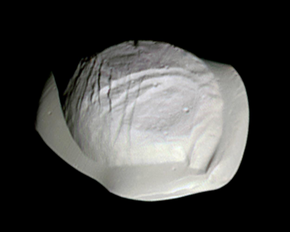 Color photo of Pan by Cassini in March 2017[a] | |
| Discovery | |
|---|---|
| Discovered by | M. R. Showalter |
| Discovery date | July 16, 1990 |
| Designations | |
Designation | Saturn XVIII |
| Pronunciation | /ˈpæn/ |
Named after | Πάν Pān |
| S/1981 S 13 | |
| Adjectives | Pandean /pænˈdiːən/[1] |
| Orbital characteristics[2] | |
| 133584.0±0.1 km | |
| Eccentricity | 0.0000144±0.0000054 |
| 0.575050718 d (13.801217 h) | |
| Inclination | 0.0001°±0.0004° |
| Satellite of | Saturn |
| Group | Shepherd moon of the Encke Gap |
| Physical characteristics | |
| Dimensions | 34.6 × 28.2 × 21.0 km (± 0.4 × 0.4 × 1.0 km)[3]: 2 |
| 27.4±0.6 km[3]: 2 | |
| Volume | 10748 km3[3]: 8 |
| Mass | (4.30±0.22)×1015 kg[3]: 3 |
Mean density | 0.400±0.031 g/cm3[3]: 3 |
| 0.0111–0.0169 m/s2[3]: 3 | |
| 0.006 km/s at longest axis to 0.007 km/s at poles | |
| synchronous | |
| zero | |
| Albedo | 0.5 |
| Temperature | ≈ 78 K |
Pan is the innermost named moon of Saturn.[4] It is a small, ravioli[5]-shaped moon approximately 35 kilometres across and 23 km wide that orbits within the Encke Gap in Saturn's A Ring. Pan is a ring shepherd and is responsible for keeping the Encke Gap free of ring particles. It is sometimes described as having the appearance of a walnut.
It was discovered by Mark R. Showalter in 1990 from analysis of old Voyager 2 probe photos and received the provisional designation S/1981 S 13 because the discovery images dated back to 1981.[6]
Cite error: There are <ref group=lower-alpha> tags or {{efn}} templates on this page, but the references will not show without a {{reflist|group=lower-alpha}} template or {{notelist}} template (see the help page).
- ^ "Pandean". Oxford English Dictionary (Online ed.). Oxford University Press. (Subscription or participating institution membership required.)
- ^ Jacobson, R. A.; et al. (2008). "Revised orbits of Saturn's small inner satellites". Astronomical Journal. 135 (1): 261–263. Bibcode:2008AJ....135..261J. CiteSeerX 10.1.1.653.3917. doi:10.1088/0004-6256/135/1/261. S2CID 122998668.
- ^ a b c d e f Cite error: The named reference
Thomas2020was invoked but never defined (see the help page). - ^ "Saturn - Moons". NASA. Archived from the original on 7 September 2015. Retrieved 5 October 2017.
- ^ "Saturn's Tiny Moon Pan Looks Like a Ravioli". CNET. Retrieved 8 January 2020.
- ^ IAUC 5052: Saturn July 16, 1990 (discovery)